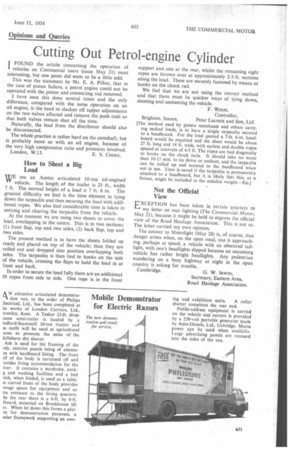Cutting Out Petrol-engine Cylinder
Page 97

If you've noticed an error in this article please click here to report it so we can fix it.
I FOUND the article concerning the operation of A vehicles on Continental tours (issue May 21) most interesting, but one point did seem to be a little odd.
This was the statement by -Mr. E. A, Pillon, that in the case of piston failure, a petrol engine could not be operated with the piston and connecting rod removed.
I have seen this done several times and the only difference, compared with the same operation on an oil engine, is the need to slacken off tappet adjustments on the two valves affected and remove the push rods so that both valves remain shut all the time. • Naturally, the lead from the distributor should also be disconnected_ The whole practice is rather hard on the camshaft, but is probably more so with an oil engine, because of the very high compression ratio and pressures involved.
London, W.13. E. S. COOKE.
How to Sheet a Big Load
wE use an Austin articulated 10-ton oil-engined " vehicle. The length of the trailer is 23 ft., width 7 ft. The normal height of a load is 7 ft. 6 in. The greatest difficulty we find is the time element in tying down the tarpaulin and then securing the load with additional ropes. We also find considerable time is taken in untying and clearing the tarpaulin from the vehicle.
At the moment we are using two sheets to cover the load, overlapping in the centre. This is in two sections: (1) front flap, top and two sides, (2) back flap, top and two sides.
The present method is to have the sheets folded up ready and placed on top of the vehicle; then they are rolled out and dropped into position overlapping both sides. The tarpaulin is then tied to hooks on the side of the vehicle, crossing the flaps to hold the load in at front and back.
In order to secure the load fully there are an additional 10 ropes from side to side. One rope is in the front support and one at the rear, whilst the remaining eight ropes are thrown over at approximately 2-3-ft. sections along the load. These are securely fastened by means of hooks on the chock rail.
We feel that we are not using the correct method and that there must be quicker ways of tying down, sheeting and unsheeting the vehicle.
F. WOOD,
Controller, Brighton, Sussex. Peter Lacroix and Son, Ltd.
[The method used by potato merchants and others carrying sacked loads, is to have a single tarpaulin secured to a headboard. For the load quoted a 7-ft. 6-in, headboard would be required and the sheet would be about 27 ft. long and 14 ft. wide, with eyelets and double ropes spaced at intervals of 4-5 ft. The ropes are tied diagonally to hooks on the chock rails. It should take no more than 10-15 mm. to tie down or uniheet, and the tarpaulin can be rolled up and secured to the headboard when not in use. Time is saved if the tarpaulin is permanently attached to a headboard, but it is likely that this, as a fixture, might be included in the unladen weight.—ED.]
Not the Official View
EXCEPTION has been taken in certain quarters to my letter on rear lighting (The Commercial Motor, May 21), because it might be held to express the official view of the Road Haulage Association. This is not so. The letter carried my own opinion.
The answer to Monolight (May 28) is, of course, that danger arises when, on the open road, one is approaching, perhaps at speed, a vehicle with an obscured taillight, with one's headlights dipped because an oncoming vehicle has rather bright headlights. Any pedestrian wandering on a busy highway at night in the open country is asking for trouble.
Cambridge. G. W. htwiN, Secretary, Eastern Area, Road Haulage Association.




















































































































































